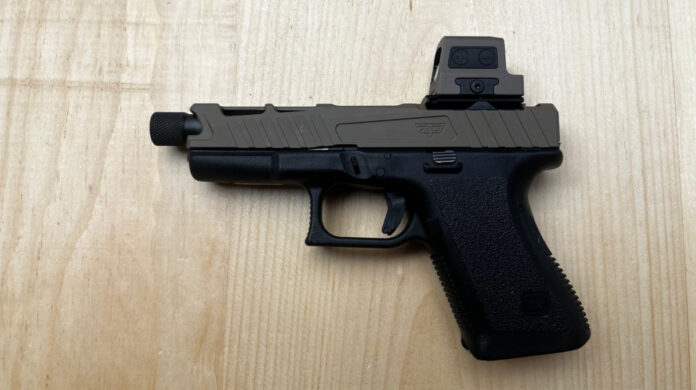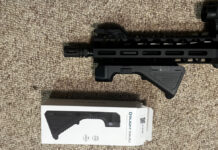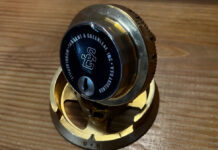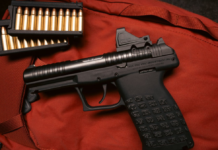
My friend Karl, who not so long ago swore he would never switch from iron sights, now has a red dot. Correction, he now has red dots on six different pistols. I consider this proof that just about anyone who tries a red dot sees the immediate advantages they offer.
I still think it is important to learn how to shoot iron sights and for all pistols to have iron sights. However, I can see a time in 30 years when only old-timers know how to get a good sight picture using a 1911 or revolver with iron sights.
At least a decade ago, as my eyes got older, I put optics on all my rifles. Most are red dots, but I also have LVPOs and fixed-magnification optics. My precision rifles still have traditional rifle scopes. More recently, I made a similar leap to red dots on pistols. In this post I share different ways to make the switch from iron sights to pistol optics.
Three Options
I own multiple Glock pistols, some of which were purchased in the 1990s. Back then, the .40 caliber pistol was considered superior to the 9mm, and pistol optics were both unusual and rarely had illuminated dots. Today, of course, bullet design has made the 9mm an effective self-defense round, small red or green dot optics are plentiful, and manufacturers are updating their handguns to be “optic ready.” Suppressors are also becoming more common. So what do you do with all your old guns that are not optic ready and do not have threaded barrels? What can you do if you have pistols in cartridges that are declining in popularity, like the .357Sig or the .40S&W? I have come up with three options.
Option 1: Buy New
Buy a new optic-ready pistol. This is what I initially did. I went from carrying a Glock 23 in .40 caliber with no optic to carrying a Glock 48 in 9mm with a green dot. The Glock 48 is thinner and lighter, and quickly became my every day carry (EDC). I am rarely without it.
My last Ruger 10/22 was also an upgrade. It is a takedown model with a threaded barrel. It also has a fiberglass stock, a Picatinny rail to which I mounted an optic, stainless steel barrel, and a better magazine release mechanism than the first 10/22 I bought back in the 1990s. The older gun with a wooden stock still shoots fine, but the new one is easier to transport and can use my suppressor.
The downside of buying new? It’s expensive, and the optic can cost half as much as the gun. If you are going to be buying your first handgun, this is a non-issue. Just be sure any compact or full-size pistols you buy are optic ready. Perhaps three older generation iron-sighted guns for the cost of one new pistol and a red dot are better for your long-term survival. As long are you are under 50 and have decent eyesight, I would not argue. Once you need reading glasses, those red dots make a big difference.
Option 2: Trade Up
Another option is to sell your old gun to raise funds to buy a new optic-ready pistol. I have not taken option 2, and I doubt I will. First, there’s nothing wrong with having multiple guns. If your fancy new EDC gun fails or is confiscated, you can use your old iron-sight pistol as a fallback. Second, it’s always good to have a spare gun you can lend to someone else if they need to be armed. And third, because everyone wants an optic-ready gun, the older models fetch less on the second-hand market than they used to. I would estimate you would need to sell your local gun dealer at least three Glock 23s to buy an optic–ready Glock 19 and a red dot.
Option 3: Update an Old Gun
Alternatively, you can update your old gun by replacing a few parts. I have just completed this process.
Because I was updating and upgrading a Glock 23 I purchased in the 1990s, I bought a new slide with the optics cut. It cost $150. I picked up a parts kit for $40. Later, I picked up threaded 9mm barrel on sale for less than $30. It took about ten minutes to assemble the slide, and voila, I had turned my old Glock 23 into a new-ish new Glock 19.
If you start with an older Glock 19, you just have to buy the slide with an optic cut, take the parts out of the old slide and install them in the new one. That means you could have an optic-ready gun for $150. That’s a $400 to $500 savings versus buying a new Glock 19. There are many slides available from a range of supplier, so you can pick the color and slide cuts/design that you like best or that meets your budget. I found what I needed at Aim Surplus.
In my case, the cost of upgrading was higher because I was switching calibers. I also wanted to keep the old slide intact. I can now switch back and forth between 9mm and .40 as easily as swapping the slide and magazine.
Two things to note: First, I got the 9mm slide in coyote tan, thinking the color will remind me the guns is a 9mm. I have a large investment in .40 ammo and magazines. I also have a .40 caliber pistol-caliber carbine (PCC) that uses Glock magazines. Thus, I am not abandoning the .40 as a defensive caliber. I am, however, putting it in the backseat. The 9mm is my primary gun and caliber, and for $220, I have what is effectively a brand new Glock 19. I will carry it when I carry my 9mm PCC because the magazines are interchangeable.
Second, the ejector on a Glock 19 and 23 are slightly different. However, the Glock 23 extractor usually works fine with the 9mm barrel. Test your gun and make sure the upgraded one functions flawlessly.
Glock Barrels
In case you are wondering, you cannot drop a Glock 23 barrel into a Glock 19 slide. The barrel’s exterior diameter is too large, meaning the .40 caliber barrel will not fit in the hole at the end of the lock 19 slide. This was a bummer for me, but by waiting for a sale, I got a new Glock 19 barrel on the cheap. I also got a threaded barrel, meaning if I ever get a 9mm suppressor, I have a pistol and a 9mm pistol caliber carbine that can use it.
(I don’t see much of a use case for a suppressed 9mm hand gun in a prepping scenario, but I could be convinced otherwise. For now, I will rely on a suppressed subsonic .300 blackout or .22LR.)
Another option to change your Glock 23 to shoot 9mm is to buy a 9mm barrel designed to fit in a Glock 23. This specialty barrel has the exterior dimensions of a Glock 23 barrel but a 9mm chamber and bore. It won’t fit in a Glock 19, but it works just fine shooting 9mm in a Glock 23.
I bought one of these conversion barrels from Lone Wolf about 10 years ago and tested it out. It worked fine, but has sat in my safe ever since. My justification at the time was with the standard military and so many police agencies carrying 9mm handguns, the day might come when I need to shoot 9mm in a post-SHTF scenario. This is a cost-effective way to shoot 9mm in a .40 Glock, but it doesn’t address the red dot issue.
Updating the AR15
You can also refresh your AR-pattern rifle. Some may not remember, but quad rails were the cool new thing about 20 years ago when the Clinton Assault Weapons Ban ended. I have removed at least two of these bulky, uncomfortable rails from my older ARs and replaced them with thinner handguards featuring M-Lok rail attachment points.
Besides swapping out quadrail handguards, I have also removed the old A2 handguard and front sight posts and replaced them with new gas blocks and a longer handguard with a rail. This is a great way to modernize an older AR. Some might argue the older fixed sight was more rugged, but as optics grow more durable, the importance of iron sights declines. Nonetheless, I made an effort a few years ago to ensure all my ARs have backup iron sights.
I have also added adjustable stocks, like the Magpul ACS, and swapped in different pistol grips on older ARs. As long as your upper received doesn’t have handle, you can upgrade any AR to feature the latest bells and whistles. Just be careful you don’t inadvertently break any laws when upgrading your AR, like making a short-barreled rifle instead of a pistol with a brace.
Why Bother Updating?
Updating or upgrading an old guns is a choice, as is using a red dot. You don’t have to do either. I find it makes the guns more ergonomic and my shooting more accurate. That’s a win whether I am target shooting or defending myself.
Some guns, however, like my FAL, will not be updated because the cost-to-benefit ratio is too high. If I want a fancy FAL (I don’t), I would be better off buying one new.
Likewise, I still have traditional, wooden stocked weapons, some of which are older than I am. They are not going to be updated. All your guns don’t need to be tactical. For example, that old Winchester 94 that has killed dozens of deer over a couple generations will continue to do so, even without a red dot. Likewise, I can’t see mounting a red dot or even a laser on the snub nose revolver I carry in my pocket. But the larger frame gun on my waist? Red dots increase my accuracy, especially at longer ranges. To me, it’s a worthy upgrade.






